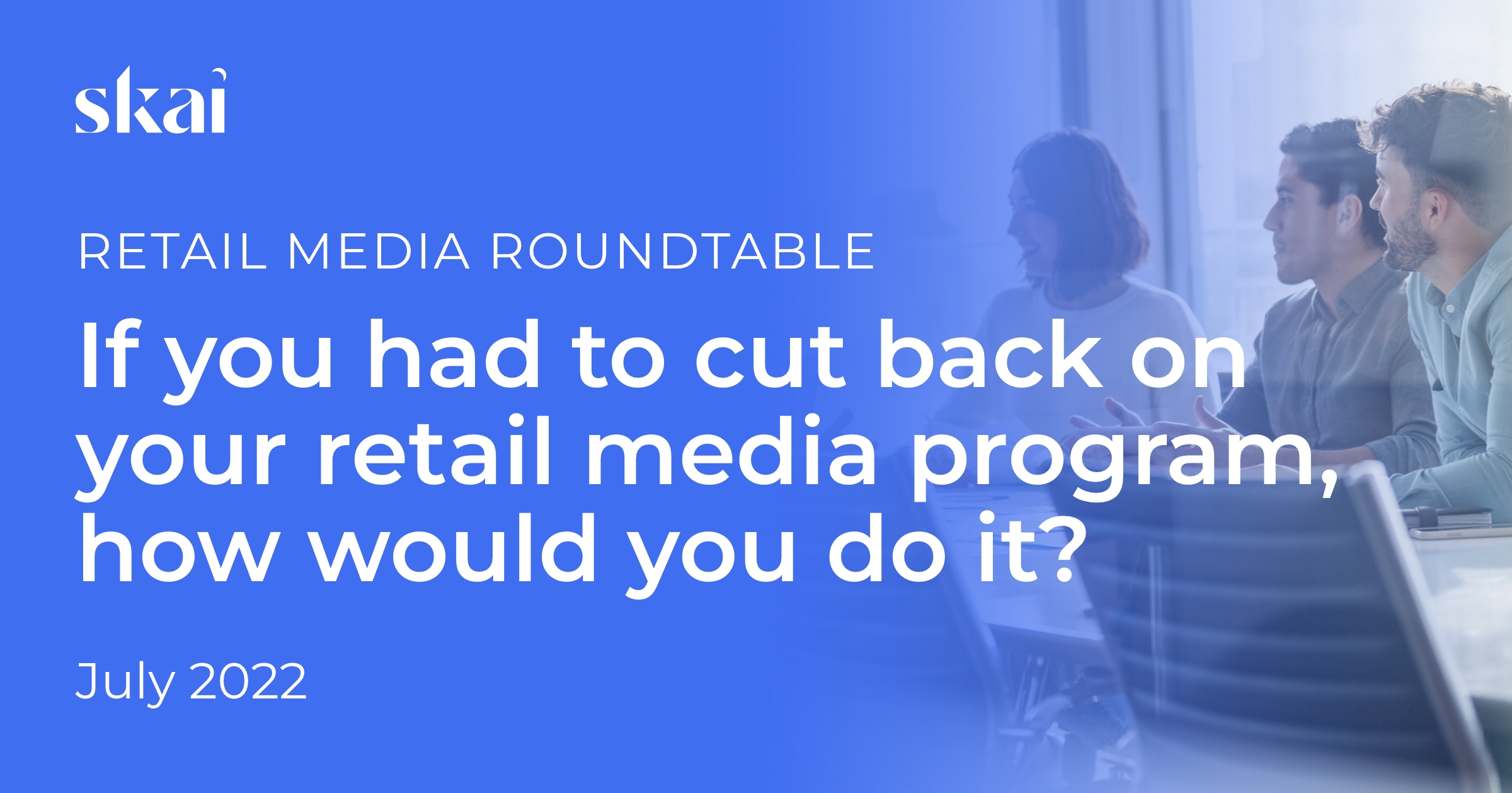
Joshua Dreller
Sr. Director, Content Marketing @ Skai

Joshua Dreller
Sr. Director, Content Marketing @ Skai

Market trends, strategic changes, and other factors may sometimes require advertisers to reduce some of their planned spending. These decisions are generally made with full awareness of the impact that budget reduction has on sell-through, and calibrated with any spend commitments made with retailers.
Of course, the task is not just to decrease spending, but to do it in a way that has the
I’d start with sponsored ad spend, where I typically spend the majority of my budget. Analysis of search query reports tends to yield strong insight into where you can optimize, and this would be the first type of report I’d use as a way to expand negative keyword lists and reduce spend on broad and phrase match keywords. (Selfishly, I’d use Skai’s Search Term Analysis feature to help me automate this process).
I’d also follow up on search query report analysis by making budget and bid price reductions on Automatic targeting campaigns, which typically serve on detail pages. I’d also gather any data I can on intraday performance, including insights from Amazon Stream (formerly FEADs), and devise a dayparting strategy. Depending on how much I need to reduce spend, I’d either pause campaigns during non-peak shopping hours or reduce budgets to focus my reduced advertising budget on the times when I believe customers are most likely to purchase. I’d execute dayparting not only on my sponsored ad spend but also on my upper- and mid-funnel retail media spend as well.
Lastly, I’d pivot my data to find underperforming segments and pull different levers to reduce investment in those segments. In general, I would strive to maintain spend focused on each level of the funnel, and look to optimize for each primary KPI against my benchmarks, while limiting investment in net-new test & learn tactics.
Cutting back is never easy, but if you do it carefully, I believe you can mitigate the impact until your budgets go back up while also maximizing each dollar you invest during the period of reduction.
– Kevin Weiss (Industry Lead, Retail Media @ Skai)
Do you have any burning questions you’d like to ask our expert panel? Would you like to contribute to this series? If so, please reach out to our content director, Josh Dreller, at joshua.dreller@skai.io.

First, what are your brand’s sales and advertising goals for each retailer, and is your brand achieving them?
Second, how much of your sales with each retailer are from advertising?
Third, if your brand isn’t advertising or advertising less, will you create a vacuum, and will a competitor fill the void
With the answers to these questions, you can compare retailers and retail media channels to understand which channel must be supported to attain your brand’s goals, reduce waste and maintain market share.

Unfortunately, those same customers tend to be the largest of their competitors, making this approach more of a tactic than a strategy. To maximize the value of retail media advertising budgets or any budget at all, we look to the retail landscape itself, seeking to drive budgets to where our clients can create a mutual win for the retailer, the shopper, and the brand. This is not to say that we ignore the big guys, but instead place additional emphasis on winning in the places and spaces where our target customer will be most impacted if we spend…or conversely, don’t spend.
At the heart of the work we do, we ensure that we are building budget allocations that align with the customer role, the category role, and the product role. We prioritize retailers that can convert shopper transactions and are able to tell our story both on and off platform. We place greater emphasis on locations with shoppers that look and behave like our targeted shopper. And when we do that, we can ensure that we are being efficient and effective with our budgets, creating the trifecta of wins – for the customer, the shopper, and the brand.

Budget maintenance is one of the most important functions of a digital advertiser. We see budgets shift all the time. When a client wants to cut budgets the first thing we ask is “why?”
Is it a profitability issue? Are those additional funds going to be moved elsewhere? There is no cookie-cutter approach, so as always, understanding the client’s goals is paramount to making healthy decisions for the brand.
We often recommend leaving as much budget as possible in low-funnel activities. If your budgets are too top-heavy you can spend a ton of money attracting people at the top of the funnel only to lose them to competitors that have secured the bottom. This means keeping budgets on the platforms that the brand sells on. If the brand sells on Amazon and Walmart we will cut budgets from Facebook or Google before cutting Amazon budgets.
In the case that the brand is only advertising on a single platform, to begin with, we usually start by cutting competitive targeting. This typically sees the least return and does the least to help the brand organically. If that doesn’t free enough of the budgets, we may cut into some branded or category spending depending on the brand’s goals.
As with all questions around digital advertising, understanding goals is the first step. The why of the action is almost always as important as the action itself.

Advertising with a strong product strategy is important. Before you even start the cost-cutting exercise, determine your priority products. These are the products that are most important to your business from a strategic standpoint. What determines these priorities may be profitability, seasonality, product life stage, inventory or other factors important to your business. Once you have this list of priorities, you’ll have a better understanding of the products where you have an opportunity to pull back.
Share of voice reporting will help you get an understanding of where you rank compared to competitors in both paid and organic listings. Are some products dominating natural search? You may have an opportunity to pull back advertising spend on these products. Do you lack competition on some keywords? Perhaps you can pull back here as well. Inventory on hand should also always be a consideration. If inventory is limited, consider pulling spend from these products.
As part of Skai’s™ intelligent marketing platform, our Retail Media solution empowers brands to plan, execute, and measure digital campaigns that meet consumers when and where they shop. Built with best-in-class automation and optimization capabilities, our unified platform allows you to manage campaigns on 30+ retailers including Amazon, Walmart, Target, and Instacart all in one place.
Client results include:
To learn more about how Skai surfaces Amazon Marketing Cloud insights—or to see our full Retail Media solution in action—please schedule a quick demo today!
You are currently viewing a placeholder content from Instagram. To access the actual content, click the button below. Please note that doing so will share data with third-party providers.
More InformationYou are currently viewing a placeholder content from Wistia. To access the actual content, click the button below. Please note that doing so will share data with third-party providers.
More InformationYou are currently viewing a placeholder content from X. To access the actual content, click the button below. Please note that doing so will share data with third-party providers.
More Information